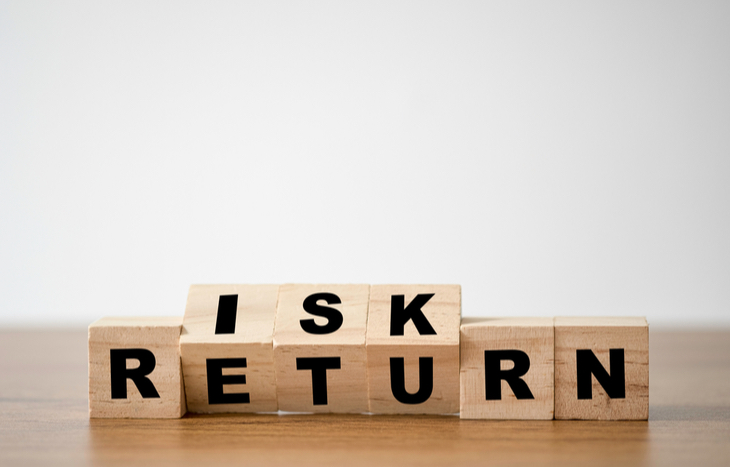What is Investment Risk?
Everyone understands the concept of risk, even from childhood. But most of us think of risk in the tangible sense: something that happens right away. Investment risk is different. What is investment risk? It’s a concept that can take years (even decades) to play out. Moreover, investment risk isn’t any one specific thing: it’s actually a collection of factors under the umbrella of “investment risk.”
It’s difficult for many people to understand investment risk until they’ve suffered from it. Hindsight is 20/20! That’s why it’s so important for new investors to get acquainted with risk before they choose where to put their money. Here’s a crash course in investment risk and what it can mean for your future.

The Definition of Financial Risk
Investment risk—also called financial risk—is an umbrella definition. It encapsulates many different risk factors that come with investing money. It refers to the broad idea that, unlike put and take (cash) accounts, you could lose money on an investment. If you put $10,000 in the stock market and there’s a severe economic downturn next year, your $10,000 might end up as $5,000. Or, the opposite could occur. A roaring bull market could turn your $10,000 into $15,000 over the course of a year.
When you put money into different investment vehicles, you choose to assume risk. The expectation is that your money will appreciate (reward). This is why most investment products balance on a ratio of risk and reward. If you take on more risk, you expect a higher reward. If you’re risk averse, you’ll choose low-risk, low-reward products.
The bottom line is that risk represents the loss you’re willing to take for a proportionate reward. If you invest $10,000 with the intent on gaining $5,000 in the next 12 months, you need to be okay with losing that same amount. Savvy investors use this idea as a measure of their mettle.
Types of Investment Risk
As mentioned, “investment risk” is a broad term for different risk catalysts. It’s not always one single risk factor that makes an investment good or bad. Here’s a look at some of the most prevalent factors that contribute to general investing risk.
- Business risk. The executive team running a business has a lot to do with that business’ success. You take a risk in trusting their vision and management model when you invest in that company. There’s also risk in how representatives of that company conduct themselves from a legal standpoint.
- Volatility Risk. Bullish and bearish market forces drive prices up or down, depending on sentiment. There’s volatility day-to-day within the market, and you assume the risk of these ups and downs as you invest. These are forces beyond your control, highly subject to many factors.
- Inflation risk. Inflation is ever-present, hovering at about 2% annually. There’s a risk that rising inflation can drive down the ROI of your investment—particularly if there’s sector-specific inflation. There’s always a risk that your investment will underperform due to unforeseen and unaccounted for inflation losses.
- Interest rate risk. Interest rates govern virtually every type of investment. These rates change frequently and can trend up or down based on broader economic factors. There’s ever-present risk that comes with interest rate variability.
- Liquidity risk. Certain types of investments can tie up your funds for extended periods of time. If you need that money now, you’re faced with a decision. You can go without and suffer in the short-term, possibly damaging your financial stability. Or, you can pull your funds out of the market and cut your investment short. Too much of your money tied up in assets creates liquidity risk.
Many times, all these factors combined dictate the overall risk of an investment. There are also risk factors you can’t account for—catalysts caused by random chance. There are an infinite number of variables that affect market performance, and accounting for them all is impossible. Instead, it’s best to focus on the largest risk factors and assess them before you decide to make an investment.
What is Your Risk Tolerance?
Risk is unavoidable when it comes to investing. Instead of avoiding risk, ask yourself how much risk you’re willing to accept in return for proportionate reward. This is your risk tolerance. When you’re prepared to lose a certain amount of money for the prospect of gaining that sum, you’ve come to terms with risk. This is something everyone needs to do before they put money into an investment.
It’s important to realize that risk tolerance can change, and that risk varies depending on the situation. A 60-year-old investor should have a much lower risk tolerance than a 20-year-old, simply based on investing time horizon. Moreover, someone who makes $100,000 each year will have a better tolerance for risk when it comes to a $20,000 investment, as opposed to someone who makes $50,000 each year. Find your risk tolerance for each investment and invest with confidence.
Every Investment Comes With Risk
As soon as you choose to invest your money, you choose to assume risk. The level of risk you take on depends entirely on how you invest your money. What is investment risk without an assessment of reward? Investors need to decide how much of their initial investment they’re comfortable losing and make sure the reward is proportionate (or higher).
In fact, this is why it’s so important to set investment goals. Sign up for the Investment U e-letter below and find the right path to a successful investment journey.
At the end of the day, it’s important to remember that markets go up over time. There’s always a chance that market forces could sink in the short-term. That’s part of the risk you need to accept. Invest with a long-term mindset and use investment risk as a tool for determining your tolerance for volatility. And remember, your risk tolerance can and should change over time. Constantly reassess and make sure you’re never risking more than you’re comfortable with on investments.





